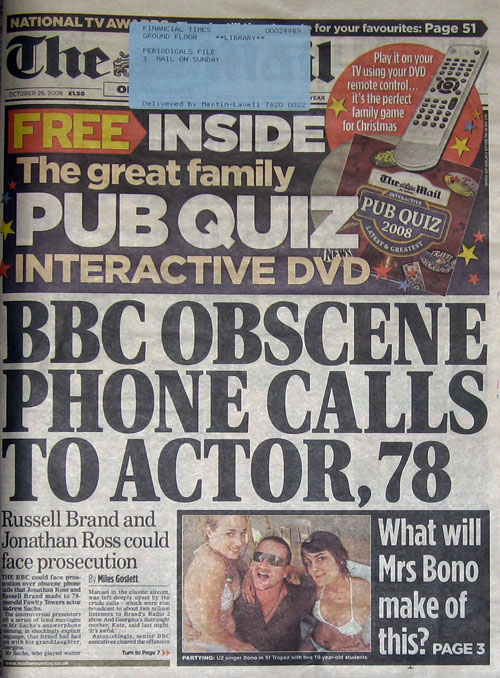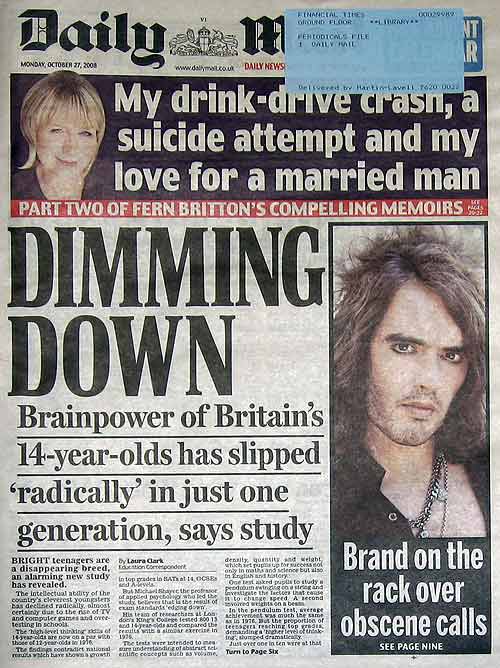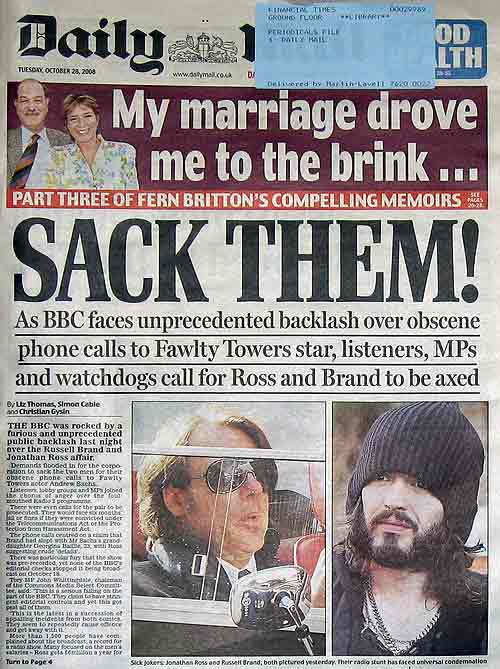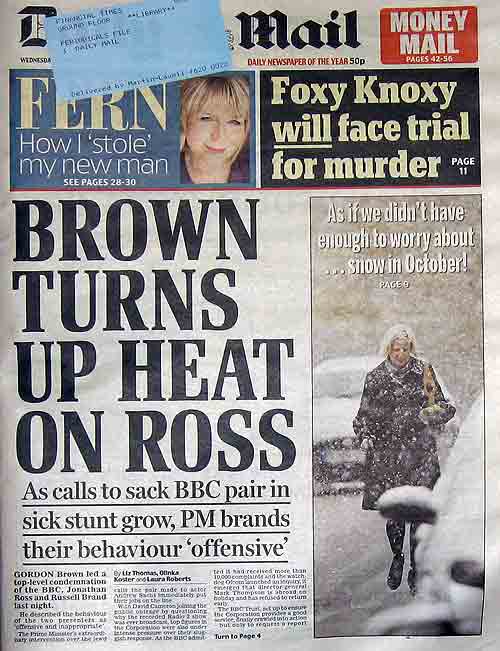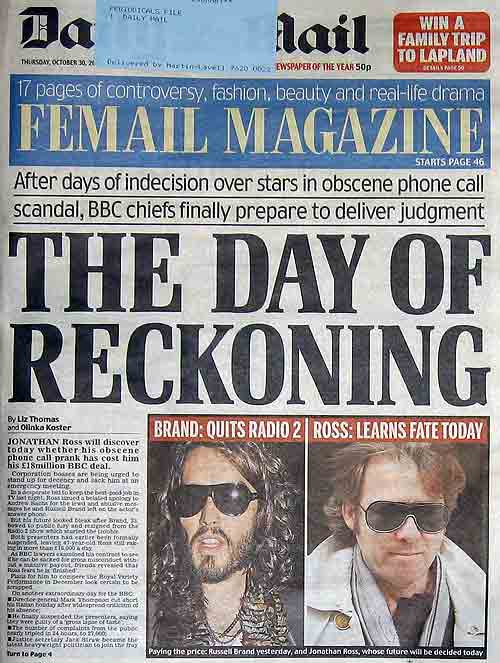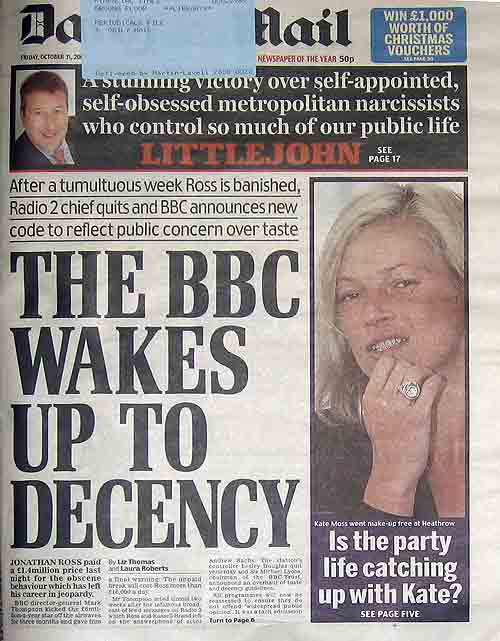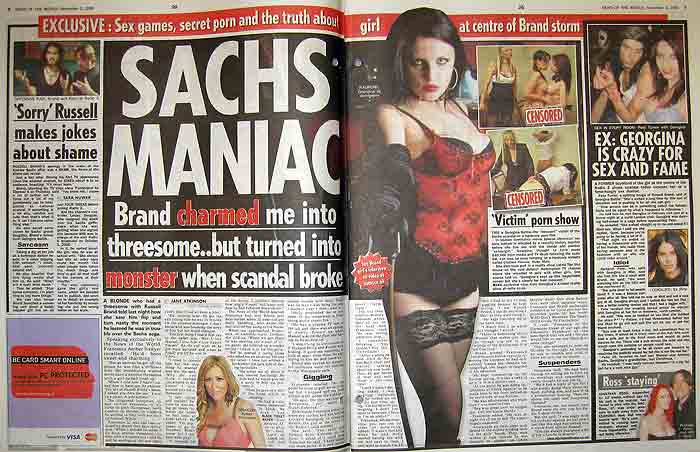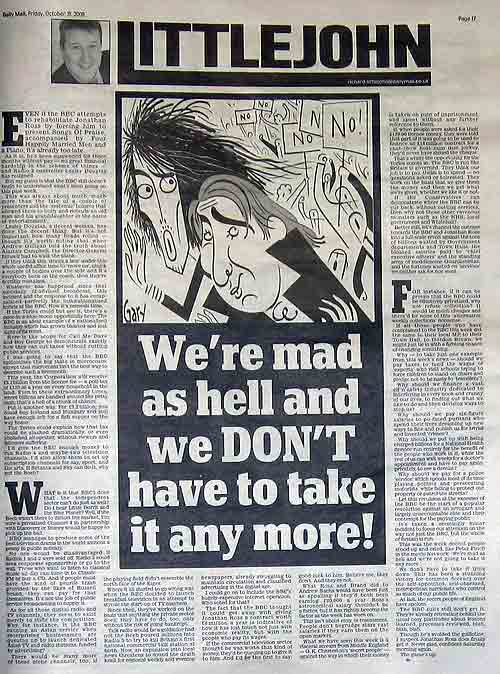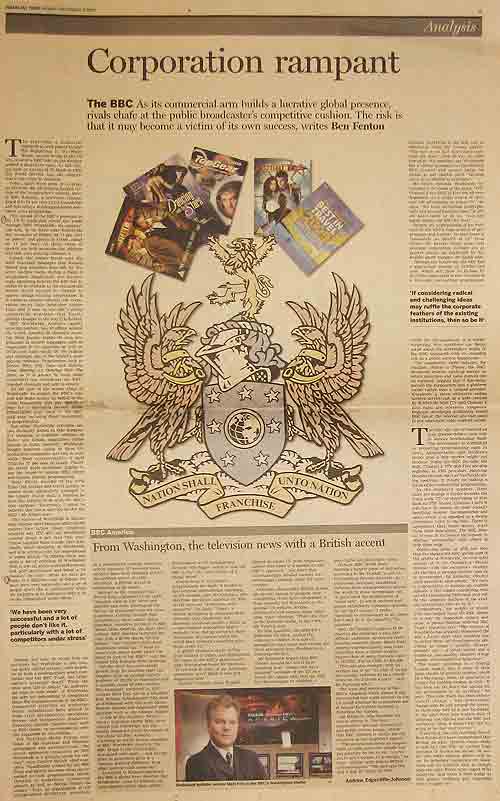Celebrity,
the press,
and issues
for the
hospitality industry
by Tony Quinn
Glion Institute of Higher
Education,
Switzerland
- The BBC's Brand-Ross scandal
- The nature of celebrity
- Other sources of fame
- Making and breaking
- What has this got to do with you?
- Lessons for the hospitality industry
- Sources and contact details
The BBC's Brand-Ross scandal
| Russell Brand | Jonathan Ross | Andrew Sachs | Georgina Baillie |
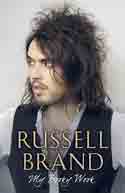 |
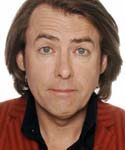 |
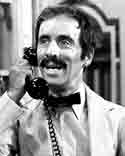 |
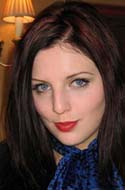 |
| Aged 33 Thought to be paid a six-figure sum for his weekly radio show His autobiography My Booky Wook, came out in 2007 and sold 600,000 copies – 'Part funny, but part hugely disturbing . . .' Grazia 'The most talented stand-up comedian. Audiences ... debauched by his erotic misadventure' Daily Telegraph |
Aged 47 Paid £6million a year for his TV chat show, Radio 2 show and film programme Received an OBE in 2005 |
- Spanish waiter Manuel in BBC's Fawlty Towers with John Cleese - Family fled from Germany in 1938 to escape persecution by Nazis |
Sachs' 23-year-old grand-daughter |
What happened? |
|||
|
|||
|
Mail on Sunday, Sunday 26 October – 8 days after the broadcast
|
|||
Within a week
|
|
Monday
|
Tuesday
|
Politicians became involved |
|
Wednesday
|
Thursday
|
Friday
|
|
|
|
News of the World, Sunday, November 2
|
|
|
|
|
|
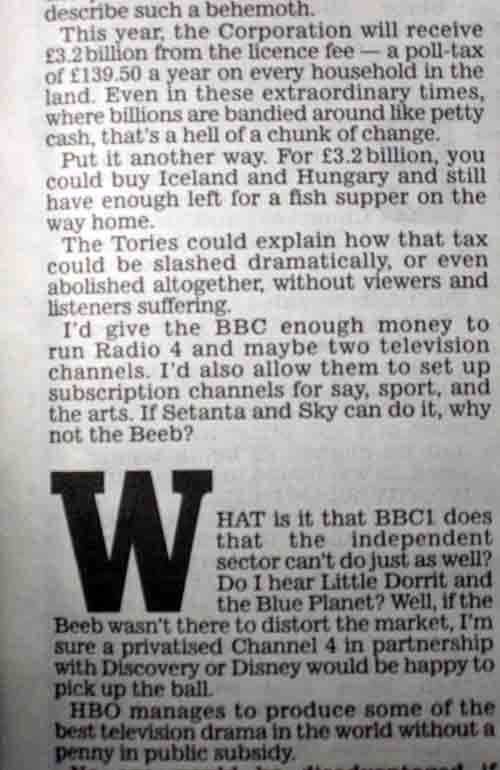 |
|
|
|
|
|
|
Now, the role of the BBC is the subject of debate across the whole Press and mother media (Financial Times, Monday November 3 – the FT is owned by Pearson, owner of Penguin Books, Pearson Education and many other book publishers) |
|
The nature of celebrity
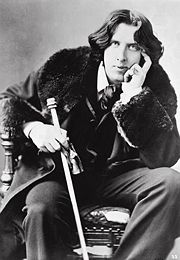 |
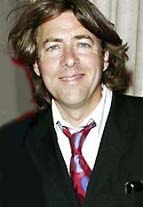 |
| Oscar Wilde: long-haired Victorian wit, author and playwright | Jonathan Ross: long-haired TV presenter and sharp dresser |
Clive James, the Australian writer, broadcaster and critic, contends that true fame was almost unknown before the 20th century, because of the lack of global media.
- Every country had locally famous people
- The British Press created national celebrities
- British celebrities became international celebs
- One of the first was Oscar Fingal
O'Flahertie Wills Wilde (died
in 1900)
- He was known for his barbed wit – and homosexuality
- US politicians complained he was given too much coverage there
- As with Brand and Ross, that's a common reaction even today
However, Wilde was an exception. Most famous people were:
- Royalty and heroes, deserving of fame, and
- Villains.
 |
 |
| 1910 royalty: the death of Britain's Edward VII (and the first tabloid scandal) | 1913 hero: Scott of the Antarctic |
 |
|
| 1910 villain: Crippen captured with the aid of new technology – wireless | |
Manufactured celebrity |
|
|
|
 |
|
1927 hero: Lindbergh Yet Alcock and Brown had made the crossing in 1919 – it was hardly reported because, unlike Lindbergh, they had not set up a publicity deal with a newspaper such as the Mirror |
|
1932: the perils of celebrity
|
|
Other sources of fame |
|
|
|
 |
|
| Joan Collins on the front cover of weekly Picture Post (11 September 1954). It quoted a forthright Collins: ‘They’re always carrying on about there being no women of star material in England. They don’t bother to build us up. They concentrate on building the men.’ | |
Making and breaking
- The Press has the ability to create, sustain – and destroy – celebrities
- It has developed since Press photographers first had cameras built into their hats to snatch pictures back in the early 1900s
- Newspapers compete with magazines – Hello!, OK!, Heat, Closer - for news and pictures
- A-list stars are being seen less in individual Western countries
- They have to spread their exposure to emerging economies such as China, Russia, India, Brazil
- OK! fought a seven-year legal battle with Hello! and won £1 million in damages after the latter snuck photographs from the wedding of Catherine Zeta-Jones and Michael Douglas. However its legal costs were estimated at £8 million
- English Footballer Wayne Rooney and girlfriend Coleen McLoughlin have agreed a £1.5 million deal with Hello! for exclusive coverage of their wedding in June
Two stars on the rise:
Aygness Deyn feted as the new Kate Moss
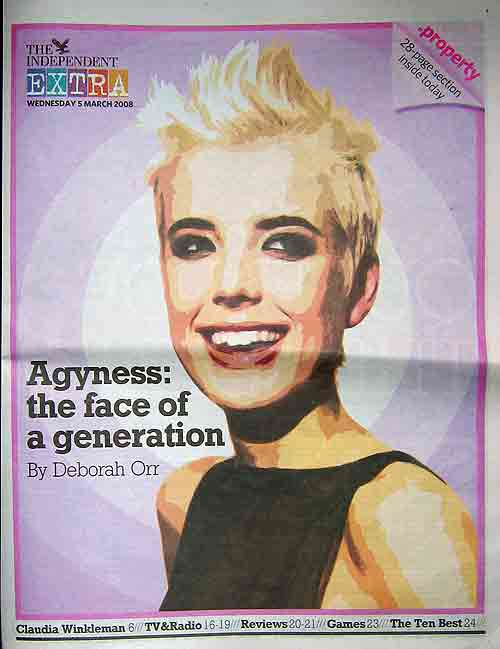
Princess Eugenie praised as a beauty in Telegraph/Tatler
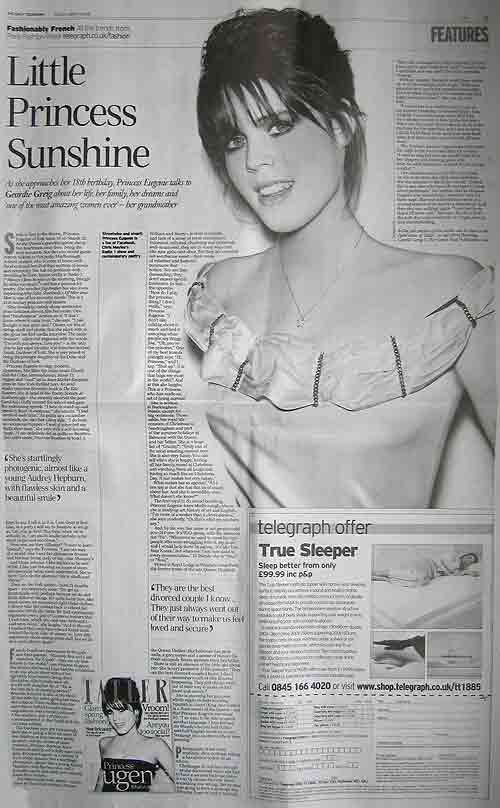
But
next day, it's revealed the pictures were doctored
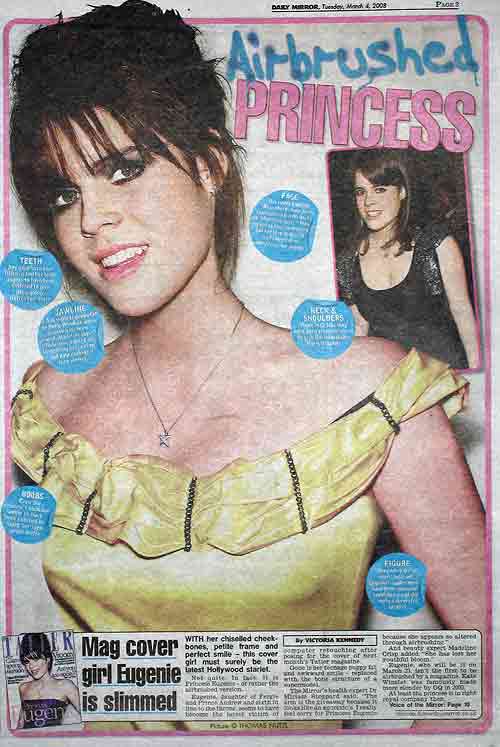
And a star well into her career

What has this got to do with you?
The answer is – where do celebrities get up to what they do?
- In 1955, jazzman Charlie 'Bird' Parker was found dead in a suite at the Stanhope Hotel in New York belonging to Pannonica 'Nica' de Koenigswarter (one of the Rothschilds). It caused a right scandal – he was black and took drugs, she was an English noble and took 3 days to report the body! Under US apartheid then, he should not even have been in the hotel.
- The Who's guitarist Keith Moon celebrates his 21st birthday in 1967 by hurling a five-tier cake around the party in his room, empties the fire extinguishers on his floor and drives a car into Flint Holiday Inn's pool – damages totalled $24,000. He then slipped on some marzipan and smashed his front teeth
- The Dakota building in New York – a block of serviced flats – is best known as the place where John Lennon lived and outside which he was gunned down in December 1980
- INXS frontman Michael Hutchence was found dead in his room at the Ritz-Carlton in Sydney (1997)
- Security camera footage of Princess Diana and Dodi al-Fayed at the Paris Ritz before their fatal crash has been regularly shown as a results of the inquests into their deaths (1997)
- Amy Winehouse and husband emerge bloodied after fight in room a London's Sanderson (2007)
Sean Bean's wedding celebrations
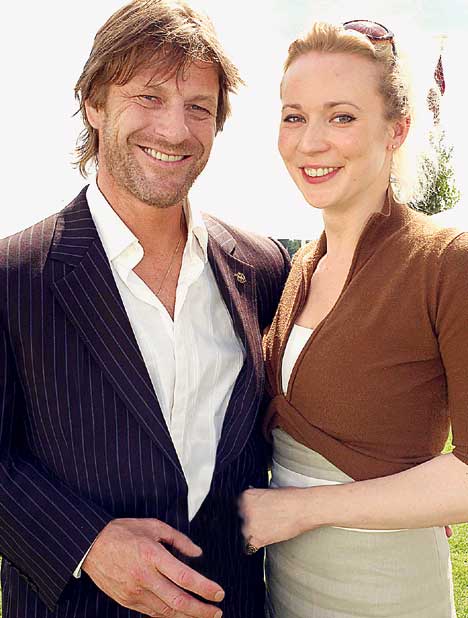
Sean Bean's wedding to Georgina Sutcliffe was called off at just 24 hours' notice – including the reception scheduled for Brown's Hotel in London's Mayfair. The Lord of the Rings and Goldeneye actor had a bust-up 18 months earlier that left both of them bruised and bleeding at the Four Seasons in Los Angeles. The hotel's incident book recorded:
'Ms Sutcliffe had numerous bruises on her upper body, face and scratches on her legs.' Bean was also left bleeding from scratches to his face and arms.
Celebrity breeds celebrity
Bean chose Brown's £3,000-a-night honeymoon suite because of the hotel's fame:
- Graham Bell made his first successful British telephone call from Brown's in 1876;
- Rudyard Kipling wrote The Jungle Book there;
- Regular visitor Agatha Christie based her book At Bertram's Hotel on Brown's;
- It was founded by Lord Byron's former valet.
The Wikipedia entry for the Stanhope list its famous deaths!
And how about this news story this year:
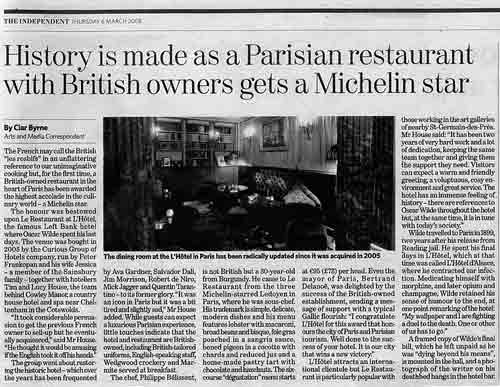
L'Hotel in Paris achieved fame after Oscar Wilde died there. Since then celebrities have flocked in:
- Eva Gardner
- Salvador Dali
- Jim Morrison
- Robert de Niro
- Mick Jagger
- Quentin Tarantino
Lessons for the hospitality industry
Know the law: what can the paparazzi and reporters do in your hotel, bar, club or restaurant?
How should you deal with the Press? Remember they are an opportunity and a threat.
Would you allow your incident book to be seen by the Press?
What would you do with a celebrity
- drunk
- high on drugs
- smashing up a room
in your hotel?
Again, celebrity antics are an opportunity and a threat!
Would you take a bribe for information from a reporter?
Sources
- Anon, 'The Royals and the Press', www.pbs.org/wgbh/pages/frontline/shows/royals/etc/cron.html
- D-Notice committee D Notice Committee explained by the Guardian
- Engel, E. (1997) Tickle the Public: One hundred years of the popular press, Indigo
- James, C. (1993) Fame in the 20th Century, BBC Books
- Seymour, D. and Seymour, E. (2003) A Century of News: A journey through history with the Daily Mirror, Contender
tony -at- magforum.com
(c) November 2008-2022
